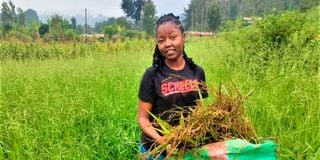Young farmer makes cash from grass

Teresa Kibiri harvests her brachiaria grass in Nyeri County. The 25-year-old says she ventured into growing grass with a capital of Sh10,000.
Clad in black T-shirt, blue denim pair of trousers and gumboots, Teresa Kibiri, 25, uproots and fills a sack with brachiaria grass.
She has been growing the grass for more than five years.
Kibiri, who is pursuing Bachelor of Science in Fashion Design and Textile course at Kirinyaga University, says she started growing the grass after completing her diploma studies in Fashion Design at Nyeri National Polytechnic.
The young woman says she ventured into the business with Sh10,000.
“I partnered with my sister Zipporah and mother, Mary Kahanya. We have three acres,” Kibiri says.
The three have two acres of brachiaria in Classic, near Nyeri town and an acre of Super Napier pakchong 1 in Kagere, Othaya.
“Unlike other crops, grass takes short time to mature. It is a promising business. I got a few cuttings from abroad through a friend who had visited Kenya and propagated them,” she says.
“We also offer training on fodder production at our demonstration farm and through WhatsApp groups and zoom meetings.”
Kibiri, her sister and mother plant the grass directly or first deep them in a root enhancer fertiliser, then add manure when planting.
Reduced rainfall
“We market our grass countrywide and abroad through social media. The major challenge is climate change,” Kibiri says.
“Rains have reduced at an alarming rate in the last few years. There is competition for the available irrigation water.”
She adds that another challenge is pests.
“Some varieties of brachiaria like Mullato 2 and Cayman are attacked by spider mites, especially during the dry season. These mites are very difficult to control,” she says.
The young farmer reveals that some varieties can be baled for hay and silage.
A rooted brachiaria split goes for Sh5.
Kibiri says super Napier pakchong 1 has crude protein of 16 to 18 per cent.
“It is harvested 90 days after planting. The grass grows to a height of 10 feet,” she says.
A cutting is sold for Sh50. An acre requires 3,000 cuttings, which can be propagated after 90 days to expand the land under grass.
“Running a dairy farm successfully means one must give his or her cows the right fodder. Farmers should set a small portion of their land for hybrid fodder,” the young woman says.
Her plan is to reach as many Kenyans as possible.
“I want to educate Kenyans on these grasses. They need to make maximum profits from their farming business. I hope many young Kenyans will embrace agriculture,” she says.
Kibiri is setting up 24 acres of grass in Rumuruti as the demand for hay increases.
“I hope to expand the business beyond Nyeri County,” she says.
Jackline Mulwa, an agronomist in Wote, Makueni County, says brachiaria grass can spread fast, contributing to soil conservation and stopping erosion.
“The grass is a long term source of feed as it regenerates in a very short time after cutting or grazing. It is more affordable, palatable and nutritious compared to commercial feeds,” she explains.
The agronomist adds that since brachiaria has no harmful additives or preservatives, milk and meat from animals that have fed on it are safer for consumption.
“It is a good climate change mitigation method,” she adds.
According to the agronomist, the grass thrives in drained soil and in areas receiving annual rainfall of above 700mm. The mean temperature should be 19 degrees Celsius.
“It does better in lowlands (altitudes below 1800m above sea level),” she adds.
“When planting the seeds, drill in shallow furrows about 1cm deep and 50cm between the furrows and when planting seeds in a nursery, drill the seeds in 1cm deep furrows and 5cm between furrows.”
However, she says that splits/cuttings should be planted using spacing of 30cm between the cuttings and 50cm between the rows.





